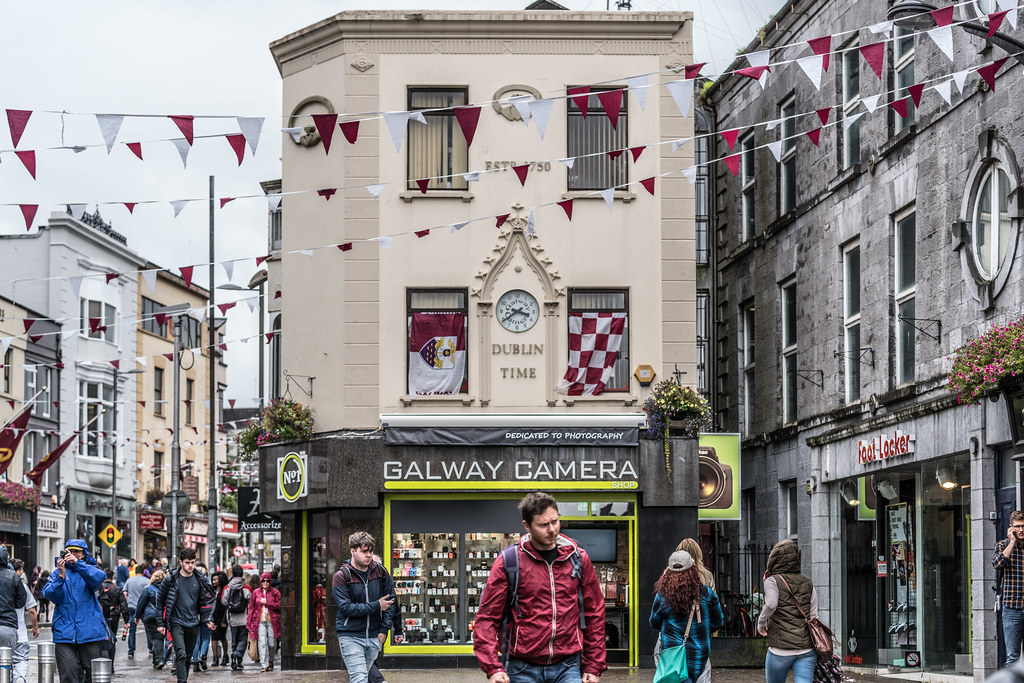DUBLIN TIME IN GALWAY PHOTOGRAPHS BY WILLIAM MURPHY

DUBLIN TIME IN GALWAY
PUBLIC CLOCK [DUBLIN TIME AT THE GALWAY CAMERA SHOP]
Before 1880, the legal time at any place in the United Kingdom of Great Britain and Ireland was defined as local mean time, as held by the appeal in the 1858 court case Curtis v. March. The Statutes (Definition of Time) Act, 1880 defined Dublin Mean Time as the legal time for Ireland. This was the local mean time at Dunsink Observatory outside Dublin, and was about 25 minutes 21 seconds behind Greenwich Mean Time (GMT), which was defined by the same act to be the legal time for Great Britain.
After the Easter Rising, the time difference between Ireland and Britain was found inconvenient for telegraphic communication and the Time (Ireland) Act, 1916 provided that Irish time would be the same as British time, from 2:00 am Dublin Mean Time on Sunday 1 October 1916. Summer time (daylight saving time) had been introduced in May 1916 across the United Kingdom as a temporary efficiency measure for the First World War, and the changeover from Dublin time to Greenwich time was simultaneous with the changeover from summer time to winter time.
John Dillon opposed the first reading of the Time (Ireland) Bill for having been introduced without consultation of the Irish Parliamentary Party; he said the different time in Ireland "reminds us that we are coming into a strange country". T. M. Healy opposed the second reading on the basis that "while the Daylight Saving Bill added to the length of your daylight, this Bill adds to the length of your darkness".
After the Irish Free State became independent in 1922, subsequent developments tended to mirror those in the United Kingdom. This avoided having different times on either side of the border with Northern Ireland.
Summer time was provided on a one-off basis by acts in 1923 and 1924, and then on an ongoing basis by the Summer Time Act, 1925. The 1925 act provided a default summer time period, which could be varied by ministerial order. Double summer time was considered but not introduced during the Emergency of World War II.[
From 1968 standard time (GMT+1) was observed all year round, with no winter time change. This was an experiment in the run-up to Ireland's 1973 accession to the EEC, and was undone in 1971. In those years, time in Ireland was the same as in the six EEC countries, except in the summer in Italy, which switched to Central European Summer Time (CEST). One artefact of the 1968 legislation is that "standard time" legally refers to summer time; the 1971 act defined a period of time in the winter as "winter time" during which the time observed would be GMT, leaving "standard time" unchanged.
From the 1980s, the dates of switch between winter and summer time have been synchronised across the European Union.
Before 1880, the legal time at any place in the United Kingdom of Great Britain and Ireland was defined as local mean time, as held by the appeal in the 1858 court case Curtis v. March. The Statutes (Definition of Time) Act, 1880 defined Dublin Mean Time as the legal time for Ireland. This was the local mean time at Dunsink Observatory outside Dublin, and was about 25 minutes 21 seconds behind Greenwich Mean Time (GMT), which was defined by the same act to be the legal time for Great Britain.
After the Easter Rising, the time difference between Ireland and Britain was found inconvenient for telegraphic communication and the Time (Ireland) Act, 1916 provided that Irish time would be the same as British time, from 2:00 am Dublin Mean Time on Sunday 1 October 1916. Summer time (daylight saving time) had been introduced in May 1916 across the United Kingdom as a temporary efficiency measure for the First World War, and the changeover from Dublin time to Greenwich time was simultaneous with the changeover from summer time to winter time.
John Dillon opposed the first reading of the Time (Ireland) Bill for having been introduced without consultation of the Irish Parliamentary Party; he said the different time in Ireland "reminds us that we are coming into a strange country". T. M. Healy opposed the second reading on the basis that "while the Daylight Saving Bill added to the length of your daylight, this Bill adds to the length of your darkness".
After the Irish Free State became independent in 1922, subsequent developments tended to mirror those in the United Kingdom. This avoided having different times on either side of the border with Northern Ireland.
Summer time was provided on a one-off basis by acts in 1923 and 1924, and then on an ongoing basis by the Summer Time Act, 1925. The 1925 act provided a default summer time period, which could be varied by ministerial order. Double summer time was considered but not introduced during the Emergency of World War II.[
From 1968 standard time (GMT+1) was observed all year round, with no winter time change. This was an experiment in the run-up to Ireland's 1973 accession to the EEC, and was undone in 1971. In those years, time in Ireland was the same as in the six EEC countries, except in the summer in Italy, which switched to Central European Summer Time (CEST). One artefact of the 1968 legislation is that "standard time" legally refers to summer time; the 1971 act defined a period of time in the winter as "winter time" during which the time observed would be GMT, leaving "standard time" unchanged.
From the 1980s, the dates of switch between winter and summer time have been synchronised across the European Union.